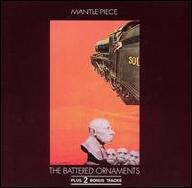And when Cream took the airwaves and the listeners on both sides of the Atlantic by storm, with the singles Sunshine of Your Love and White Room, not to mention a brace of LP tracks off of their album Disraeli Gears, Brown suddenly emerged as a major background figure in the British pop music world. It was around this same time that the First Real Poetry Band got recorded by a friend of Brown's, and there was talk of a possible commercial release. Meanwhile, Brown carried his songwriting activities forward on behalf of the Graham Bond Organisation, a precursor ensemble to Cream who had hung on up to that point, but were soon to break up -- the process left him with a large repertory and a problem; amid the stellar lineup of the First Real Poetry Band, his singing was the weak link, as he was the first to admit, and rather than try to elevate his skills, he decided instead to recruit a less imposing group of sidemen to work with, and the First Real Poetry Band passed into history.
At the core of the new band was reedman Nisar Ahmed Khan (aka George Khan), playing alongside Lynn Dobson, while Jamie Muir -- still a few years away from his work with King Crimson -- played percussion at first, though Pete Bailey had replaced him by the time they got around to recording. Khan put Brown on to guitarist Chris Spedding and bassist Butch Potter, and Dick Heckstall-Smith was aboard on tenor sax, and Charlie Hart -- later much better known as a bassist -- played the organ and violin, and Bob Tait played drums. Their sound was a strange mix of blues and jazz, channeled through psychedelia and some avant-garde sensibilities, and overall extremely difficult to classify. Despite the latter shortcoming, however, audiences liked the outfit billed as Pete Brown His Batterered Ornaments. The bookings were plentiful and the work was not only starting to pay decently, but they soon had representation by Blackhill Management, which, as they discovered, had entre to EMI Records' newest imprint, Harvest Records. This was all happening in late 1968 and early 1969, when there was still a thriving underground music scene in England, and Brown and company fit right into the zeitgeist.
But as 1969 wore on, and a first album -- A Meal You Can Shake Hands with in the Dark -- was released, and did well enough so that a second one was recorded -- a process similar to the one that had overtaken Brown's first band began to occur within the Battered Ornaments. They began to get more ambitious in their musical goals, and also to see Brown's still limited -- but highly expressive -- vocalizing as a detriment. This time, however, it was the band that made a move on Brown rather than the other way around. Matters came to a head in early July 1969, when Brown was essentially voted out of the band he'd organized, unanimously. When the smoke cleared, the core of five musicians remained, with Spedding installed as lead singer. The second version of the Battered Ornaments was a tighter band, and a thoroughly more professional sounding outfit, despite some limitations -- Spedding was obviously a more natural musician than Brown, but his vocals, while more professional, weren't any better, and were a lot less interesting.
The group set about wiping Brown's singing from the completed second LP and substituting Spedding, with backup singing by all of the others. And the results, while smoother and more professional, were also a good deal duller without Brown's contribution to the music. The original Battered Ornaments might have been unclassifiable in terms of their music, but with Brown as the frontman there was an unpredictable element -- which extended itself from his singing to the playing of the others, by emotional and musical osmosis -- that kept listeners of all sorts engaged in the finished tracks. The second album, by the new Battered Ornaments, sounded like a bunch of highly talented jazz players doing good work that was a lot more predictable and not half as interesting. (In a sense, in terms of the internal dynamics of the band -- which very much shaped its sound and playing -- the departure of Brown had an effect similar to the loss of Brian Jones in the lineup of the Rolling Stones; the latter group had got Mick Taylor, a true virtuoso on the guitar, who could take solos that neither Jones nor Keith Richards ever would have thought of playing, in his place, but they lost all of the unpredictability that Jones himself had brought to the table, and lot of the edgy tension that went with it; except, of course, that the Battered Ornaments had no Mick Jagger in their ranks, or even anyone quite as charismatic in his dark way as Keith Richards, to keep pulling people into their orbit.)
It all ended by 1970, in the wake of the critical and commercial failure of Mantle-Piece, when Spedding accepted an offer to work on Jack Bruce's first solo album, Songs for a Tailor (which, ironically, was comprised of songs with lyrics by Pete Brown), and later joined Bruce's touring band. The Battered Ornaments were mostly forgotten over the ensuing decade, as the members moved on to other projects, Brown emerging with a new band called Piblokto while Spedding went on to become a top session player with one huge British hit (Motor Bikin') to his credit, and Charlie Hart became a member of Ronnie Lane's Slim Chance, in addition to being a busy sessionman. ~ Bruce Eder, Rovi












